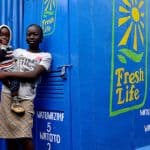Weekly Roundup: A Different Kind of Pivot in SE Asia, a Surprising Collaboration in India and South Africa’s Sweet Move
President Barack Obama this week wrapped up his final trip to Asia in his attempt to “pivot” his foreign policy agenda eastward. Although the results of Obama’s trip are in dispute, there’s little debate when it comes to the growing clout of Southeast Asia’s entrepreneurial class – including its bumper crop of social enterprises.
It’s a long-term trend that can’t be summed up in a single Roundup post. Nevertheless, it feels like just about every week we hear about a new conference, incubator, accelerator, fund or university program designed to enable startups – from Singapore to the Philippines to Laos.
“From our perspective at the National University of Singapore (NUS), we observe a remarkable and growing interest in social entrepreneurship,” wrote associate professors Audrey Chia and Lim Yee Wei last month. “NUS hosts a social venture competition each year. Last year we had 683 entries and this year we have 1,027. The quality of entries has also improved.”
In July, 50 “developed social enterprises” and 30 private-public sector partners participated in the first-ever ASEAN Conference on Social Entrepreneurship in Singapore, where they met with and pitched to investors. The finalists will make a final pitch to investors in October in Jakarta. (Singapore also plays host to the BoP World Convention next month.)
“One of the main reasons why social innovation and entrepreneurship is flourishing is because many old policies and ways of working cannot solve some of today’s most pressing global issues. It requires truly novel solutions,” Jean Tan, executive director of Singapore International Foundation, said in a press release.
Krisztina Tora, who leads the Global Social Entrepreneurship Network, which supports early-stage social entrepreneurs, recently wrote about the gelling of many social business groups in the region and some of the deep-seated cultural issues social entrepreneurs often face:
“There (is) general agreement that talent is a major barrier for social entrepreneurs and their supporters. This is especially true in Asia where there is societal and parental pressure to have a ‘successful career’ (i.e. a traditional/conservative vision of what professional success looks like) and therefore entrepreneurship is seen as a sort of failure or a last resort choice.”
And as Sankalp Forum pointed out in its e-newsletter this week: “Despite facing the typical challenges of operating in an emerging market, what is interesting in the Filipino ecosystem is the number of startups that are focusing on social impact, and the creative solution of the government for increasing the impact of SMEs: GoNegosyo. Corporations are playing their part as well, backing social enterprises as a means to achieve the SDGs.”
Is this an anecdotal list? Absolutely. And comparing one region’s social enterprise prowess to another is risky business. But considering the burst of activity across Southeast Asia, it’s everyone’s business to pay a bit more attention.
– By Scott Anderson
Truth Tweet
In Development, It’s Not the First Time in History that it has been the First Time in History pic.twitter.com/5oc67DhJwN
— William Easterly (@bill_easterly) September 9, 2016
Can Google Boost India’s Financial Literacy?
India’s financial inclusion drive has scored some impressive successes – including bringing some 77 million women into the formal banking system in just one year. But the outlook isn’t entirely rosy: Almost 76 percent of Indian adults lack an adequate understanding of key financial concepts, according to a recent survey, and the country’s household savings rate has fallen significantly.
To address these issues, the government is apparently turning, in part, to Google. According to unnamed Google and Indian government representatives quoted in the Economic Times, the tech behemoth is designing a website and mobile app called Bharat Saves, which it hopes to align with the national financial inclusion initiative.
The site, which is targeted at homemakers, small business owners, the newly employed, retired persons and farmers, will reportedly include two phases. First, users must log in, complete financial literacy modules, and take a financial literacy test. Then they will be able to access a second section of the platform, where they can compare and purchase banking and insurance products.
Since this is Google we’re talking about, it’s hard to avoid concerns about the privacy of low-income users, and how all this detailed data on their financial lives will be put to use. But assuming the government keeps any of Google’s more aggressive data-collecting impulses in check, this could be an exciting collaboration.
– By James Militzer
Mixed News for Microfinance
The latest quarterly report from India’s Microfinance Institutions Network underscores the sector’s growing momentum in the country. A few highlights:
- Credit disbursal grew by 29 percent in the April-June period, and loan portfolios have grown 89 percent industry-wide since the first quarter of 2015-16.
- Microfinance is proving to be an important source of security for the elderly in underprivileged communities, with microfinance institutions (MFIs) seeing their pension accounts grow by 108 percent in the first quarter, compared to the same time last year.
- On the downside, smaller MFIs seem to be struggling to access capital, with large MFIs receiving over 90 percent of debt funding from banks and other financial institutions this quarter.
On a more somber note, new analysis from some prominent researchers points toward some troubling findings for the global industry. According to Bob Cull, Asli Demirguc-Kunt and Jonathan Morduch, the industry remains largely dependent on subsidies – including most for-profit MFIs. What’s more, “dependence on subsidies declines but does not disappear as institutions become older,” and those subsidies often aren’t focused on expanding access to those who might benefit most from them, including poorer customers and women. The research was based on data from 930 microfinance institutions with some 80 million combined customers. One intriguing takeaway: The findings “underline the importance of pursuing new ways to change the cost structure faced by most microfinance institutions such as digital payments and mobile money.”
– By James Militzer
ImpInv report
Just launched: Latin American #impinv report w/ @lavca_org & @LGT_IV! Check it out – https://t.co/2SzwHBaWPd pic.twitter.com/euE2KWpzgU
— ANDE (@AspenANDE) August 31, 2016
Following Sisu to success
NextBillion’s been following Sisu Global Health for years. Not just because they invented a badly needed product – the Hemafuse, a low-cost blood transfusion device – but because they’re providing a roadmap on how to commercialize it.
From their thoughtful, inclusive design phase through their funding efforts, the three women behind Sisu (including two graduates from the University of Michigan, NextBillion’s stomping ground) have taken carefully measured steps in pursuit of their passion.
This week, they announced that they’ve reached 80 percent of the goal in their $1 million seed round, recently netting $500,000 from the Camden Partners Exelixis Fund – the first investment made by the new fund focused on growing companies in Maryland. Meanwhile, they’re beginning clinical studies of the Hemafuse in Ethiopia.
If your goal is to solve a global health problem with technology, you’d do well to read up on Sisu. If you do, be prepared to be impressed.
– By Kyle Poplin
South Africa’s sweet move
South Africa’s Department of Health explained this week why, starting in 2017, it will become the first African country to charge a tax on sugar-sweetened beverages. Bottom line: People there are fat and getting fatter, and obesity is overall bad for business.
It’s clear that free markets can solve problems, but market tweaks from government, such as “sin taxes,” can modify behaviors and save lives while easing skyrocketing health care burdens on specific economies.
South Africa is an appropriate place to try the tax. One in four South Africans are obese and one in five consume an excessive amount of sugar – 17 teaspoons per day, on average, almost double WHO’s recommended amount. But it’s clear that excessive sugar consumption is a global problem. The average Mexican, for example, consumes 35 teaspoons per day. That led Mexico to impose a tax similar to South Africa’s, and it’s “been relatively effective in reducing the consumption of sugary beverages,” tax expert Kyle Mandy told the BBC.
South African officials should, of course, monitor the tax after implementation to weigh its benefits and costs, but in the meantime they should be applauded for being the first on their continent to take this particular step in the battle against non-communicable diseases.
– By Kyle Poplin
IN CASE YOU MISSED IT … THIS WEEK ON NEXTBILLION
Finding the Right Last-Mile Distribution Model
Stopping the Spread of ‘Superbugs’: Six Promising Solutions
What We’re Learning Every Step of the Energy Ladder
The Volatile ‘Face’ of Digital Financial Services in Zambia
Photo by John Ragai via Flickr.
- Categories
- Uncategorized



